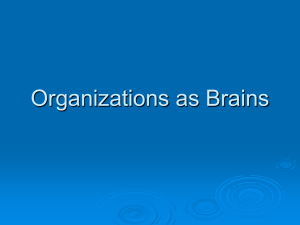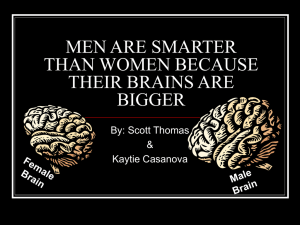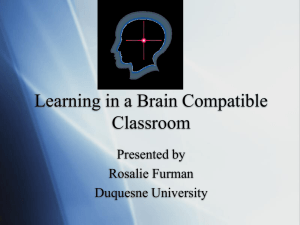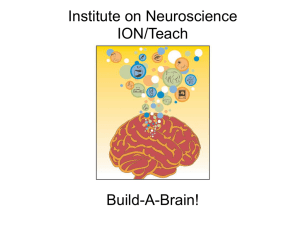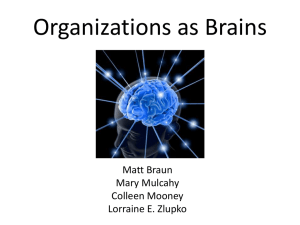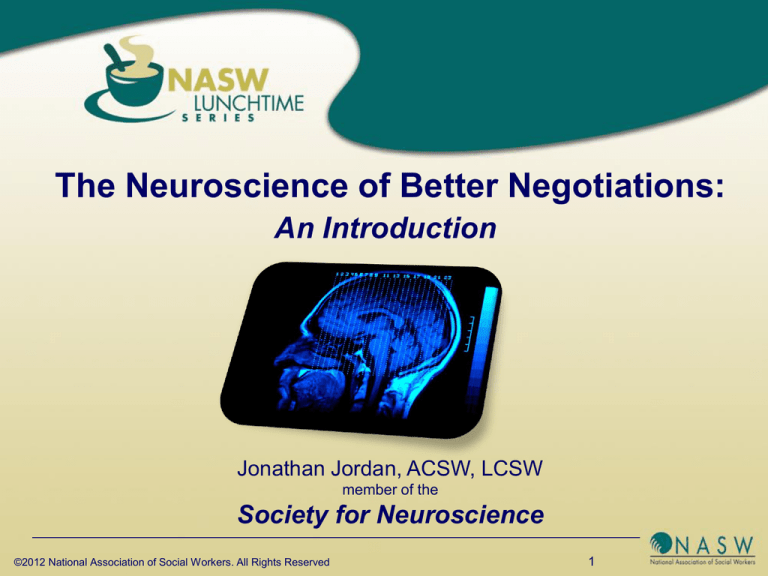
The Neuroscience of Better Negotiations:
An Introduction
Jonathan Jordan, ACSW, LCSW
member of the
Society for Neuroscience
©2012 National Association of Social Workers. All Rights Reserved
1
“Geniuses don’t have more brain power than the
average person,
they just use their brains more efficiently”
©2012 National Association of Social Workers. All Rights Reserved
2
Improvements In BrainImaging Technology
Have Led to…
Incredible Breakthroughs in Neuroscience
©2012 National Association of Social Workers. All Rights Reserved
3
Recent Neuroscience
Breakthroughs
in Plain English
Neuroplasticity & “Mirror” Neurons
2012 National Association of Social Workers. All Rights Reserved
4
Neuroplasticity…
in Plain English
• Neuroplasticity is the changing of neurons, the
organization of their networks, and their function via
thinking, learning and activities
• Neuroplasticity occurs in the brain:
– At the beginning of life: when the immature brain
organizes itself.
– In case of brain injury: to compensate for lost functions
or maximize remaining functions.
– Through adulthood: whenever something new is
learned and memorized
©2012 National Association of Social Workers. All Rights Reserved
5
Self-Directed
Neuroplasticity
• Our brains are constantly changing, rewiring, making new connections
between synapses. These changes are a result of the brain's
neuroplasticity
• As these brain remodels take place, we have two choices. We can let
them just happen, or we can awaken "our faculties," direct the
changes, and turn neuroplasticity into self-directed neuroplasticity (a
phrase coined by Jeffrey Schwartz)
• When our brains are engaging in neuroplasticity without our
knowledge, direction, or awareness, our brains are changing
accidentally. When we are employing self-directed neuroplasticity, we
are changing our brains on purpose
• Accidental and on purpose are two very different ways of being in the
world, and only one allows for autonomy and maximum performance
©2012 National Association of Social Workers. All Rights Reserved
6
“Mirror” Neurons
in Plain English
Observation of an action of another
automatically triggers simulation of that action
in the brain of the observer
Neurons in the premotor cortex fire during
goal-directed actions as well as the
observation of similar actions
“Mirror” neurons provide a neural basis for
imitation and empathy (inner imitation)
In other words, people copy actions,
emotions, and mindset of those near them –
our brains mirror the brains of those around
us
©2012 National Association of Social Workers. All Rights Reserved
7
Two Primitive Brain Circuits
that Greatly Impact Negotiations, and Life in General
A quick overview…
©2012 National Association of Social Workers. All Rights Reserved
8
Focus: To Survive
Flight-or-Fight
Stress
Neuroendocrine
changes include an
increase in Cortisol
– “the stress
hormone”
©2012 National Association of Social Workers. All Rights Reserved
Focus: To Thrive
Relaxation
Response
Trust
Neuroendocrine
changes include an
increase in Oxytocin
– “the trust
hormone”
9
A Quick Look at
What Happens to Our Brains
In The Threat Mode
©2012 National Association of Social Workers. All Rights Reserved
10
Autonomic Nervous System
©2012 National Association of Social Workers. All Rights Reserved
11
Autonomic Nervous System
Limbic System
Emotional
Related to
“Reward Circuit”
in the brain
Prefrontal Cortex
Rational, Executive Functions
Autonomic Nervous System
Sympathetic Nervous System
Fight-or-Flight
©2012 National Association of Social Workers. All Rights Reserved
Parasympathetic System
Relaxation Reponse
12
Impact on Mental Clarity
Difficulties
accessing
long-term
memory
Limbic
system
aroused
Problemsolving
abilities
reduced
Ability to
remember
decreases,
impacting
learning
Pessimism and
perceived
threats/insults
increase
©2012 National Association of Social Workers. All Rights Reserved
Judgment
diminishes,
aggression
(and physical
energy) may
increase
Executive
functions: Logic
decreases,
irrationality
increases
Message
receptors shut
down,
terminates
meaningful
rapport
13
What Our Social Brains
Want…
The SCARF Model
We respond to the perception of…
• Status – how we compare to others, competition, avoidance
of being “wrong” or responsibility for being at fault
• Certainty – clarity, opposite of confusion, risk free
• Autonomy – ability to make decisions, sense of control
• Relatedness – fitting in safely, belonging to a group
• Fairness – how we are treated compared to others
©2012 National Association of Social Workers. All Rights Reserved
14
What Our Brains Want…
The SCARF Model
The more SCARF we perceive, the more our brain feels
“rewarded” and the more we trust
The less SCARF we perceive, the more our brain feels
“threatened” the more defensive we become…and maybe
more irrational
For mutually successful negotiations, you want the other
party to perceive as much SCARF as reasonably possible
©2012 National Association of Social Workers. All Rights Reserved
15
True or False:
Your Brain Can Truly Multitask?
©2012 National Association of Social Workers. All Rights Reserved
16
Your Brain Cannot
Truly Multitask
• Psychiatrist Richard Hallowell describes multitasking as a
“mythical activity in which people believe they can perform
two or more tasks simultaneously.”
• Recent neuroscience research proves multitasking is a
myth that can greatly hinder performance.
• The human brain is unable to consciously pay full attention
to two tasks at the same time.
• We can do simple tasks like walking and talking at the
same time, but when it comes to true multitasking
(consciously using your prefrontal cortex), your brain just
can’t do it.
©2012 National Association of Social Workers. All Rights Reserved
17
Studies show that a person who is attempting to multitask takes 50 percent
longer to accomplish a task and he or she makes up to 50 percent more
mistakes!
Therefore, a person working sequentially is 50% faster and up to 50% more
accurate!
Source:
John Medina,
author of Brain Rules
©2012 National Association of Social Workers. All Rights Reserved
18
A multitasking “always on” prefrontal cortex may trigger
the brain’s “threat” reaction, releasing cortisol, etc. and
leading to impaired mental functioning and decreased
ability to effectively negotiate
©2012 National Association of Social Workers. All Rights Reserved
19
How to “Trick” Your Brain Into Giving You A
Powerful Surge of Confidence When You Most
Need It
• In a recent study by Harvard Business School,
researchers physically “posed” participants into one of two
sets of poses, high- and low-power.
• High-power poses involved stretching out to take up more
space, and opening the arms/legs
• Low-power poses involved contractive positions with
closed limbs.
• The two groups showed neuroendocrine, psychological
and behavioral differences consistent with their positions.
©2012 National Association of Social Workers. All Rights Reserved
20
Cont…
• High-power posers experienced feelings of “being in charge” while lowpower poses reported a drop in confidence
• Among high-power posers testosterone (a hormone linked with feelings
of power) levels increased by 25 percent while cortisol (the “stress
hormone”) decreased by 19 percent – in both men and women
• The low-power posers experienced an opposite neuroendocrine
response – e.g., cortisol levels increased
• The implications are that we can create changes, in as little as two
minutes, in our brains simply by changing our physical stance
• Simply holding one’s body in expansive poses for as little as two
minutes can give us a significant surge of confidence
©2012 National Association of Social Workers. All Rights Reserved
21
A Power Pose To Quickly Boost Your
Brain Before a Negotiation
“These poses actually make you feel more powerful”
Says study coauthor Amy J.C. Cuddy, an assistant professor at
Harvard Business School
©2012 National Association of Social Workers. All Rights Reserved
22
If you would like a copy of this
Harvard Business School Study
Just shoot me an email at…
Jonathan@MindfullyChange.com
©2012 National Association of Social Workers. All Rights Reserved
23
“Mirror” Neurons
And Their Implications During
Negotiations
©2012 National Association of Social Workers. All Rights Reserved
24
Body Language That’s
Good For Brains,
And Negotiations
• Uncross arms or legs - it might come across as defensive
• Make eye contact - but don’t stare, it could induce a “threat”
response
• Take up space, spread out - it increases perceptions of power
• Relax your shoulders - high, tight shoulders imply tension, fear
• Nod occasionally when someone is talking – it gives the
message that you are interested
• Lean back a little in your chair – it increases perceptions of power
(if appropriate, for an even greater boost, put your hands behind
your head also)
©2012 National Association of Social Workers. All Rights Reserved
25
Body Language That’s
Good For Brains,
And Negotiations, Cont.
• Smile often, even laugh – this greatly lowers the “threat” level
• Keep your head, and eyes, up – it is a sign of confidence
• Maintain a voice modulation and tone that are calm and keep the speed
of your speech steady and not too fast – it makes you sound more
intelligent and confident
• Slow down your movements – it makes you appear more calm and
confident
• Use some hand gestures to make points – it will make you appear more
intelligent
• Smell good - or at least don’t smell bad. Interestingly, olfactory inputs
(smells) are processed by the brain more quickly than inputs
from any other senses.
©2012 National Association of Social Workers. All Rights Reserved
26
A Peek At Advanced
Methods: Purposely Match
& Mirror
• Often when you get along with a person, when the two of you get
a good connection, you will start to mirror each other
unconsciously. That means that you mirror the other person’s
body language, emotions, mindset, etc.
• To make the connection better you can try a bit of proactive
mirroring. If the other person leans forward, you might lean
forward. If he holds his hands on his thighs, you might do the
same. But don’t react instantly and don’t mirror every change in
body language – it may appear weird
• After a while, purposely change your body language slightly and
see if they “mirror” you. If so, you have gained the leading
influence
©2012 National Association of Social Workers. All Rights Reserved
27
A Peek at Advanced
Techniques
©2012 National Association of Social Workers. All Rights Reserved
28
To Summarize this
Webinar…
In order to effectively negotiate…
Avoid triggering the neurological “threat” circuits in the other party
As much as possible, activate the “reward” circuits in the other
party – you at least want to get to a perception of win-win
Boost your own confidence neurologically in preparation for
negotiations – one way to do this is adopting a “power pose”
Remember communication is largely nonverbal
Be focused and present, don’t attempt to multitask - doing so
will greatly diminish your ability to negotiate
Repeated practice influences neuroplasticity which results in
you being a brain-based negotiator by habit
©2012 National Association of Social Workers. All Rights Reserved
29
Follow Up Questions…
Presenter Contact Information
Jonathan Jordan, LCSW, ACSW
Book Website: www.MaximizeBrainPower.com
Main Website: www.MindfullyChange.com
Email: Jonathan@MindfullyChange.com
Follow me on Twitter: @MindfullyChange
Phone: (321) 214-5824
Contact me if you have further questions




